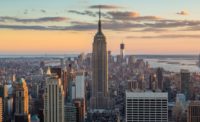Over the last decade, the green building industry has risen on the tide of a culture-wide trend toward sustainability, and many in the architecture profession believe it will continue to prosper even as the U.S. falls deeper into a recession. “I think there’s a very compelling argument that the economic environment we’re going into right now will only enhance the value of doing green,” says Guy Geier, FAIA, senior partner of FXFOWLE.

Perkins + Will, a signatory of the 2030 Challenge, designed the 69,000-square-foot New Science Facility at Lehman College in the Bronx. The firm is targeting LEED-NC Gold for the project.
A Turner Construction Company Survey conducted in November seems to confirm his hunch: Seventy-five percent of more than 750 real estate executives surveyed said the credit crunch would not make them any less likely to construct green buildings in the future. Moreover, a 2009 report by McGraw-Hill Construction found that the green-building market “seems to be somewhat insulated” from the construction slump. Reasons cited for the market’s stability include increased awareness that green buildings are often cheaper to operate, and governmental policies that promote or even mandate eco-friendly features.
Still, while the green-building movement may not be slowed by the recession, many say it will need to adapt to the new economic reality. Rick Fedrizzi, president of the U.S. Green Building Council, recently stated: “Over and over again, Americans are saying the same thing: the key to a prosperous future is sustainability.” But if the movement is to capitalize on public interest in sustainability, it will need to focus on the kinds of work most likely to attract investment from clients and from the federal government.
Jason Hartke, the USGBC’s director of advocacy and public policy, believes that the movement has much to offer President Barack Obama, who has made it clear that sustainability is central to his agenda. “Proposals around green building can be extremely attractive,” he says, “because green building is at the nexus of creating jobs, saving energy, and saving money”—three priorities for the Obama administration. The USGBC is advocating specific efforts that include greening federal facilities and weatherizing low-income homes. “Every million dollars invested in weatherization creates 52 jobs,” says Hartke. Many think the President’s recently enacted $787 billion economic stimulus plan will deliver a boost to the green-building industry, particularly in regards to infrastructure and building-modernization projects.
A focus on retrofitting, rather than new construction, is likely to be one way in which the recession affects the green-building movement. Sally Wilson, global director of environmental strategy at CB Richard Ellis, thinks there will be few opportunities to do “sexy work” in the U.S. in the coming years. Instead, she says, “the architectural community needs to quickly change gears into the existing-building side of things.”
The recession may also alter the kinds of green features and methods architects choose to employ. While strategies like natural ventilation should not be affected, high-cost features like photovoltaics may become less common, according to Robert Forest, a partner at Adrian Smith + Gordon Gill Architects. His firm designed Masdar Headquarters, a zero-carbon facility planned for Abu Dhabi. “I think aggressive sustainable design strategies will be scrutinized in terms of their lifecycle cost savings,” says Forest, who predicts there will be fewer “demonstration projects” as a result.
In fact, architects may find that the recession makes promoting green building based on lifecycle cost analyses much harder to do. Peter Morris, a principal of the international cost consulting firm Davis Langdon, says the economic downturn is revealing a flaw in those analyses—that many of them made projections based solely on data from the past few years, data that turns out to have been anomalous. Falling gas and oil prices will cast doubt on such forecasts, he notes. “By our overenthusiastic embracing of not so rigorously done lifecycle analyses,” he says, “we may have turned ourselves into Alan Greenspans of the green movement.” He hopes that the recession will foster lifecycle cost analyses that take into account the high degree of uncertainty involved in making projections.
Fluctuating energy prices and uncertainty about the economy¹s future notwithstanding, there is a general feeling among industry professionals that the recession will prove more beneficial than harmful to the green-building movement. Sustainability expert Robin Guenther, a principal of Perkins + Will, thinks initiatives such as the 2030 Challenge, which advocates for carbon neutrality in all new buildings by the year 2030, will continue to gain steam and drive innovation in green materials and construction. Certainly her firm, a 2030 Challenge signatory, isn’t backing down on its commitment. “People who build in this economy will demand building green because they’ll be more forward thinking,” she says. “I think our moment has arrived.”




